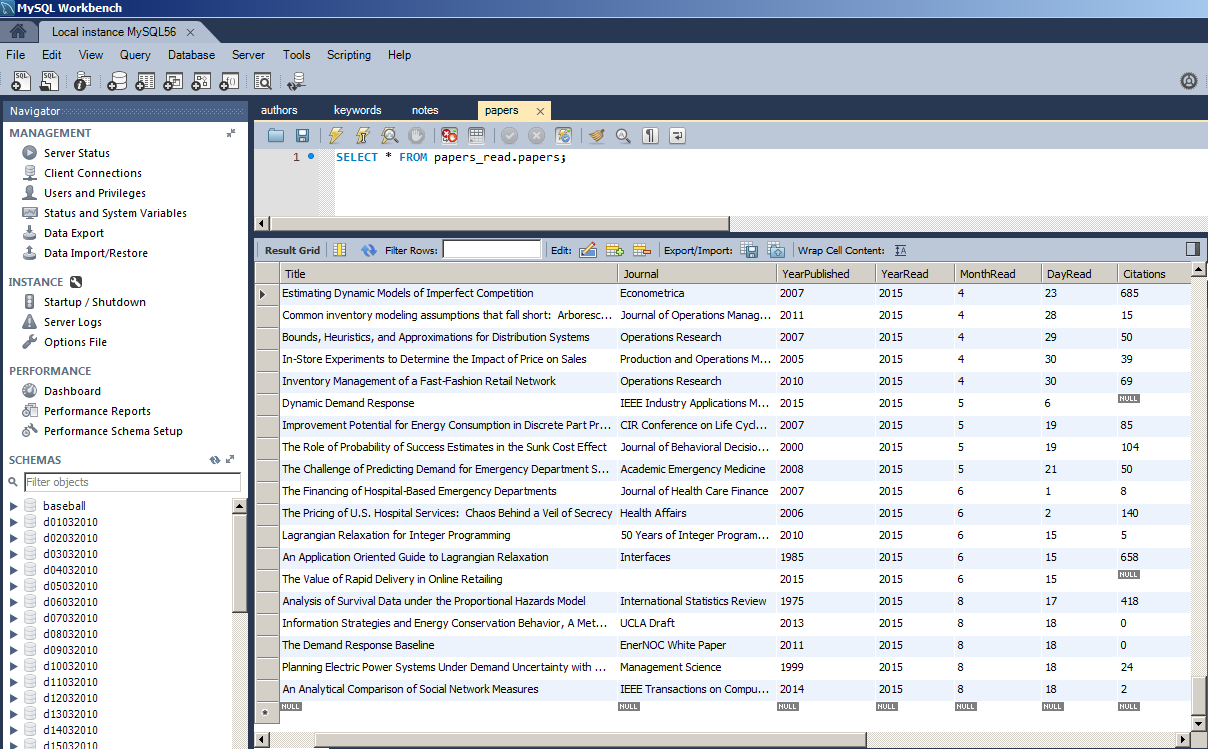I read 212 research papers in the 12 months following June 2014. Some were for coursework. Some were for research. Some were just because I felt like it.
As anyone who knows me will tell you, my memory for details is not very good. I’m more of a big picture person. So I worry that I won’t retain much from this giant expenditure of time in reading research papers.
I’d like to describe my current system for saving information from research papers for later use. I have a few use cases for this effort:
Use Case 1: Upon writing a research paper, I want to know which papers I’ve read about the topic so that the literature review moves more smoothly.
Use Case 2: When I go to interview for a job at a university, I’d like to know which papers I’ve read from the faculty there. This may provide opening discussion topics.
Use Case 3: I’d like to save my ideas for follow-up actions (after reading papers) in one place.
Use Case 4: When topics in diverse fields reference the same topic, I’d like to be the person to connect the fields.
LOW TECH SOLUTION:
Last year, I saved the first page of every research paper I read in a binder with my hand-written notes on the first page. This provides a form of storage, but it is not at all searchable or cross-reference-able.
HIGH TECH SOLUTION:
This year, I designed a template that contains all the information about a paper that I want to save. I then designed an import process to port this information from the template (text document) to a database that I can query easily. Here is my process for that, including code and database setup:
1. Install MySQL (https://www.mysql.com/) locally on your most-used computer.
2. Create a database called “papers_read”.
3. Run the code in the attached files to create your database tables (The code is attached here as .txt because my website doesn’t allow me up to upload .sql. Just fix the extension so it is “.sql”): papers, authors, keywords, and notes.
4. Create a folder on your computer called “Paper Notes to Upload”. Put the following template file in the folder: template.
5. Install Python and the related library MySQLdb.
6. Save this Python code wherever you save your code: addNewFromTemplate (again, the extension has been changed to .txt for security reasons. Rename to .py). Update the “folder_to_add” directory in the code to point to the folder you created in step 4.
Now, whenever you read a paper:
A. Fill out the template with the paper details, and save the text file as something OTHER than ‘template.txt’ in the folder created in step 4.
B. When it is convenient (there may be multiple files to upload in the “Paper Notes to Upload” folder), run the Python code. This will upload your notes to the database.
C. Move the paper notes out of “Paper Notes to Upload” folder after uploading. If you run the code again with them still in the folder, they will be uploaded again.
Some notes on the template:
-Do not use colons in any of the fields you save, as the code uses colons to parse the document. If the title of the paper has a colon in it, use a comma instead.
-I grab the number of citations from Google Scholar by searching for the title of the paper.
-“Comma-separated Keywords” is for you to list the keywords in the paper, with a comma between each.
-In the authors section, be sure to delete any extra/unused author spaces. Feel free to add more if necessary, following the pattern of the first 6.
-Under Reading Details, the Hours to Read is how long it took you to read the paper in hours (can be decimal). The Not Read is a place to list sections/pages not read. The Skimmed is a place to list sections/pages quickly skimmed for which another read would be necessary to understand all the details. Reason Read is a reminder of why you read the paper. Methodology Used lets you list the methods used in the paper (i.e. survey, lab experiment, mathematical model, optimization, etc.), if that is relevant to your work.
-Under My Notes, “Keywords for me” lets you list more keywords that the paper did not list itself (comma-separated, again). FollowUp lets you list actions that should be done after reading the paper. Note1 through Note5 let you list notes to yourself about the paper. Limit each note to 200 characters and do not add more. No need to delete unused notes.
I hope this helps. It’s the process I use. Feel free to alter to fit your needs. Let me know if you use it and if you have any questions. All the code is my own and it is fairly fragile (but works for me); feel free to let me know if you have issues or a better solution.
